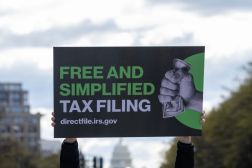USDS impact report showcases ‘a year of launching things’

With requests for help on projects from more than 100 agencies in fiscal year 2023, the United States Digital Service is one of the most sought-after units in the federal government. Dealing with that level of demand often means tough choices for leadership with the White House-based IT consultancy service.
“Frankly, there aren’t enough places for agencies to go across government when they have technical questions or need technical help, so we get a huge array of requests,” USDS Administrator Mina Hsiang said in an interview with FedScoop.
Those requests, many of which are detailed in the 2024 impact report USDS released Thursday, can’t all be addressed. Hsiang said USDS works to fulfill “over a quarter” of the agency requests for partnership, with consultation but not full engagement provided on approximately 10% of those asks.
“We do a lot of work to contemplate the size of the population impacted, the vulnerability of the population impacted, the change it will have on the service and how critical the service is for people’s livelihood,” she said.
In its report, USDS outlined progress on 10 different projects across agencies, covering topics including digital service accessibility, building veteran trust, federal benefits for families and more.
A closer look at USDS projects
In its partnership with the Social Security Administration, USDS worked with the agency to “observe customers” and learn how the public engaged with SSA’s website. According to the report, the project would save an estimated $285 million over five years for infrastructure expenses.
The partnership with SSA has “created momentum to improve service delivery” through transforming the agency’s static homepage, the report noted, replacing “complicated” policy language with a conversational eligibility screener and building development infrastructure that involves a content management system and more.
The USDS is currently working with the Department of Veterans Affairs’ Office of the Chief Technology Officer to develop software intended to improve the lives of veterans. In teaming with the agency on VA.gov, USDS aimed to build veterans’ trust in the VA. Per the report, veterans’ trust in the VA climbed from 70.4% in FY18 — the year of VA.gov’s relaunch — to 79.3% in FY23.
“The Veteran Experience Office does a very comprehensive work of engaging veterans and building an array of metrics together,” Hsiang said.
The impact report also touted USDS’s partnership with the Department of Health and Human Services to help modernize and implement services that support an interagency Life Experience Research Team, aiming for “simpler, more accessible and equitable” digital experiences. Specifically, the organization conducted research with a nationwide group of participants, documenting their experiences throughout pregnancy and childbirth along with any relevant interactions with the federal government.
Working with an HHS Life Experience Research Team that included representatives from the General Services Administration, the Department of Labor, the Department of Housing and Urban Development and others, USDS piloted three digital programs to support families, including a text message service called Notify.gov that allows government partners to send texts about benefits and support programs to the public.
“This is one of those places where we can partner very closely with an agency that’s building out a shared capability for more folks and give them direct feedback,” Hsiang said. “The team had a very good experience with it.”
Though not listed in the impact report, the USDS also worked “extremely closely” with the IRS on the implementation of its Direct File pilot program. Hsiang said the partnership was not included in the report due to a timing issue, but noted that USDS assisted in technical expertise, user research, product management and more. Direct File was utilized by over 140,000 taxpayers in its inaugural run, according to the IRS.
“This pilot is only with 12 states, but obviously there’s real opportunities for growth there because building out that capability so that folks in every state can have this option will be important,” Hsiang said. “The tax code is huge and incredibly complex, so there were almost 20 million people who were eligible for this pilot, but it will be important to expand that capability to encompass more individuals.”
A busy year followed by more to come from USDS
For Hsiang, who has led USDS since September 2021, the release of the impact report represents what she views as “a year of launching things.”
“There’s a lot of programs here that are a demonstration of incredible value in themselves, but also a proof of concept of a new model working,” Hsiang said.
USDS is investing in hiring both internally and with agency partnerships, Hsiang said, in an effort to capitalize on momentum to build long-term capacity within agencies. She confirmed that the USDS is working to support agencies in hiring more talent, including as part of efforts called out in the White House’s artificial intelligence executive order.
“I think there’s a lot of interest, but the talent moves quickly, gets hired quickly, looks for competitive salaries and opportunities,” Hsiang said. “That will definitely be a challenge, but one we’re excited to take on.”
Hsiang said her hope for this report is a “clear illustration” of what government talent is able to accomplish, and stressed the importance of USDS’s investment in technology-centered work.
“I think the report starts to give a real detailed window into the range of different types of work that we do and the short- and long-term impacts that it can have,” Hsiang said. “One of the things that we hear across government regularly is that technology ends up slowing people down instead of speeding them up, if it’s not implemented right. That is not what anyone intends and that’s not what we’re investing for.”




